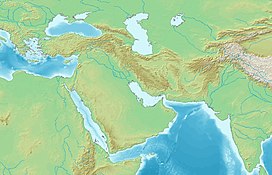
Back جبال السروات Arabic সারাওয়াত পর্বতমালা Bengali/Bangla Al-Sarat Catalan Saravát Czech Όρη Σαραουάτ Greek Montaro Saraŭat Esperanto Montes Sarawat Spanish Sarawati mäestik Estonian کوههای سروات Persian Monts Sarawat French
| Sarawat Mountains | |
|---|---|
| Sarat | |
 Sarawat mounatains of Al-Bahah, Saudi Arabia. | |
| Highest point | |
| Peak | Jabal An-Nabi Shu'ayb, Yemen |
| Elevation | 3,666 m (12,028 ft) |
| Naming | |
| Native name | Jibāl As-Sarawāt (جِبَالُ ٱلسَّرَوَاتِ) |
| Geography | |
| Countries | Yemen and Saudi Arabia |
| Range coordinates | 18°16′02″N 42°22′05″E / 18.26722°N 42.36806°E |
The Sarawat Mountains (Arabic: جِبَالُ ٱلسَّرَوَاتِ, romanized: Jibāl as-Sarawāt), also known as the Sarat in singular case,[1] is a mountain range in the western part of the Arabian Peninsula. In a broad sense, it runs parallel to the eastern coast of the Red Sea, and thus encompasses the mountains of Fifa',[2] 'Asir,[3] Taif,[4][5] and the Hijaz[6][7] (which can be seen as including the Midian Mountains).[8] In a narrow sense, the Sarawat start in Taif city in Saudi Arabia, and extend to the Gulf of Aden in the south, running along the entire western coast of Yemen, in what used to be North Yemen, and extend eastwards into part of what used to be South Yemen, thus running parallel to the Gulf of Aden.[1][9]
- ^ a b Robert D. Burrowes (2010). Historical Dictionary of Yemen. Rowman & Littlefield. pp. 5–340. ISBN 978-0-8108-5528-1.
- ^ "ThePlace: Fifa Mountains in Jazan". Arab News. 2019-02-15. Retrieved 2019-02-17.
- ^ Overstreet, William Courtney (1977). Tertiary laterite of the As Sarat Mountains, Asir Province, Kingdom of Saudi Arabia. Vol. 2. Directorate General of Mineral Resources. pp. iii–2.
- ^ Mandal, Ram Bahadur (1990). "VI: A Regional Geography". Patterns of Regional Geography: World regions. New Delhi, India: Concept Publishing Company. p. 354. ISBN 8-1702-2292-3.
- ^ Nasr, Seyyed Hossein (2013). "1: The Holiest Cities of Islam". Mecca the Blessed, Medina the Radiant: The Holiest Cities of Islam. Tuttle Publishing. ISBN 978-1-4629-1365-7.
- ^ Judas, J.; Paillat, P.; Khoja, A.; Boug, A. (2006). "Status of the Arabian leopard in Saudi Arabia" (PDF). Cat News (Special Issue 1): 11–19.
- ^ Spalton, J. A. & Al-Hikmani, H. M. (2006). "The Leopard in the Arabian Peninsula – Distribution and Subspecies Status" (PDF). Cat News (Special Issue 1): 4–8. Archived from the original on May 23, 2011.
- ^ Scoville, Sheila A. (2006). "3". Gazetteer of Arabia: a geographical and tribal history of the Arabian Peninsula. Vol. 2. Akademische Druck- u. Verlagsanstalt. p. 288. ISBN 0-7614-7571-0.
- ^ McLaughlin, Daniel (2008). "1: Background". Yemen. Bradt Travel Guides. p. 3. ISBN 978-1-8416-2212-5.


